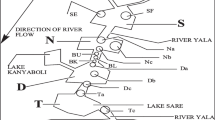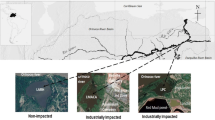Abstract
Sugarcane farming is the most important cash crop cultivation activity in the Lake Victoria basin of Kenya practised in an area covering approximately 114,000 Ha in total. For better yields, various agronomic inputs including fertilizers and herbicides have been used intensively in the farms, causing serious concerns about their potential impacts on the aquatic ecosystems within the lake basin. In this study, the physicochemical features of surface sediment and water including pH, total organic carbon contents and heavy metal (Cd, Cu, Zn, Pb and Cr) loads in River Kuywa and in runoff canals in sugarcane farms in Nzoia nucleus estate within the lake basin were determined to assess the effects of agronomic activities including agronomic inputs in the form of nitrogenous fertilizers [urea and diammonium phosphate (DAP)], herbicides and sewage sludge used in farming on their levels. The results indicated significant differences (p ≤ 0.05) in the heavy metal levels in sediment and water samples taken before and after the farms, respectively, indicating a positive impact on the concentration levels. The canal water and sediment samples’ heavy metal levels were also significantly higher than those of the river samples showing that the influent sugarcane farm canal waters transfer these contaminants into River Kuywa. Although the levels of these parameters were significantly higher in the canals than in the controls obtained from outside the sugarcane farms, the heavy metal levels in soil samples from within the farms with similar agronomic activities did not differ significantly among the various plots. The turbidity, electrical conductivity, temperature, water and soil pH and total organic carbon values in samples obtained within the sugarcane farms showed significant seasonal variations and differed significantly from the values in the controls showing a significant negative impact of agronomic inputs on water quality.


Similar content being viewed by others
References
Allen DE, Kingston G, Rennenberg H, Dalal RC, Schmidt S (2009) Effect of N. Fertilizer management and water logging on nitrous oxide emission from subtropical sugarcane soils. Agric Ecosyst Environ 136:209–217
Alloway BJ (1995) Soil processes and the behavior of heavy metals in Soils. In: Alloway BJ (ed) 2nd edn. Blackie, New York, pp 11–37
Anonymous (2006) Nzoia sugar company report Nzoia, Kenya
Antoniadis V, Alloway BJ (2001) The role of dissolved organic carbon in the mobility of Cd, Ni and Zn in sewage sludge-amended soils. Environ Pollut 117:515–521
ANZECC (2000) Australian and New Zealand guidelines for fresh and marine water quality. Australian and New Zealand Environment and Conservation Council, Canberra. http://www.mincos.gov.au/__data/assets/pdf_file/0014/316121/contents.pdf
Bahar AY, Cemal T, Tahsin T (2010) Uptake and distribution of hexavalent chromium in tissues (gill, skin and muscle) of a freshwater fish, tilapia (Oreochromis aureus). JECE 2(3):28–33
CCME (2002) Canadian Council of Ministers of the Environment, “Canadian Sediment Quality Guidelines for the Protection of Aquatic Life,” 1999, updated 2002. http://www.ccme.ca/assets/pdf/sedqg_summary_table.pdfH
EMCA (2006) Environmental management and coordination (water quality) regulations, 2006 (L.N. No. 120 of 2006). Kenya Gazette Supplement No. 68 of 29 September 2006, pp 1–25
Environment Canada (1998) Canadian sediment quality guidelines for chromium: supporting document. Environmental Conservation Service, Ecosystem Science Directorate, Guidelines and Standards Division, Ottawa
Francis S (2008) Impacts of metals on aquatic ecosystems and human health. Found at http://magazine.mining.com/issues/0804/ImpactsMetalsAquaticHealth.pdf 15-4-2011 4.20 pm
GoK (Government of Kenya) (2002) District development plan of Kenya for the period 2002–2008. Government Printers, Nairobi
Haynes D (2000) Pesticides and heavy metal concentrations in Great Barrier Reef sediment, seagrass and dugong (Dugong dugon). PhD thesis, University of Queensland
Hseu ZY, Su SW, Lai HY, Guo HY (2010) Remediation techniques and heavy metal uptake by different rice varieties in metal-contaminated soils of Taiwan: new aspects for food safety regulation ans sustainable agriculture. Soil Sci Plant Nut 56:31–52
Jain CK (2004) Metal fractionation study on bed sediments of river Yamuna, India. Wat Res 38:569–578
John ED, Terrence H, Dale VH, Georgia T, Luis T, David MK (1996) Freezing as a method of sample preservation for analysis of dissolved inorganic nutrients in seawater. Marine Chem 53:173–185
Lalah JO, Ochieng EZ, Wandiga SO (2008) Sources of heavy metal input into Winam Gulf, Kenya. Bull Environ Contam Toxicol 81:277–284
Mapanda F, Mangwayana EN, Nyamangara J, Giller KE (2005) The effect of long-term irrigation using wastewater on heavy metal contents of soils under vegetables in Harare, Zimbabwe. Agric Ecosyst Environ 107:151–165
Mzimela HM, Wepener V, Cyrus DP (2003) Seasonal variation of selectedmetals in sediments, water and tissues of groovy mullet, Liza dumerelii (Mugilidae) from the Mhlathuze Estuary, South Africa. Mar Poll Bull 46:659–676
Netondo GW, Fuchaka W, Lucy M, Tabitha N, Nelly M (2010) Agro-biodiversity endangered by sugarcane farming in Mumias and Nzoia sugar belts of Western Kenya. AJEST 4(7):437
Nouri J, Mahvi AH, Jahed GR, Babaei AA (2008) Regional distribution pattern of groundwater heavy metals resulting from agricultural activities. Environ Geol 55:1337–1343
Okalebo RJ, Kenneth WG, Poul LW (2002) Laboratory methods of soil and plant analysis: a working manual second edition. Sacred Africa, Nairobi
Oliver DC (2004) Environmental impacts of sugar production. CABI Publishers, Wallingford
OMEE (1993) Ontario Ministry of Environment and Energy. Guidelines for the protection and management of aquatic sediment quality in Ontario, August 1993. http://www.ene.gov.on.ca/envision/gp/B1-3.pdf
Ongeri DMK (2008) Physicochemical parameters, heavy metal residue levels and their speciation studies in Lake Victoria Basin. PhD thesis, Maseno University, Kenya
Ongeri DMK, Lalah JO, Wandiga SO (2010) Speciation of Cd, Cu, Zn, Fe and Pb in sediments sampled from Lake Victoria basin, Kenya. Environmentalist 30:254–259
Ongley ED (1996) Control of water pollution from agriculture: FAO irrigation and drainage paper 55. FAO Food and Agriculture Organization of the United Nations, Rome
Rhodes JD (1982) In methods of soil analysis, part 2. In: Keeney DR (ed) 2nd edn. American Society of Agronomy, Madison, pp 102–105
Tack FMG, Verloo MG (1999) Single extraction versus sequential extraction for estimation of heavy metal fractions in reduced and oxidised dredged sediments. Chem Speciat Bioavail 11:43–50
USEPA (2003) National primary drinking water standards, EPA 816-F-03-016. Available at http://www.epa.gov/safewater
USEPA (2005) Procedures for the derivation of equilibrium partitioning sediment benchmarks (ESBs) for the protection of benthic organisms: metal mixtures (Cadmium, Copper, Lead, Nickel, Silver and Zinc). EPA-600-R-02-011. Office of Research and Development. Washington, DC
USEPA (2007) 40 CFR parts 136 and 503 guidelines establishing test procedures for the analysis of pollutants; analytical methods for biological pollutants in wastewater sewage sludge; final rule EPA–HQ–OW–2004–0014; FRL–8228–1. Fed Regist 72(57)
USEPA (2009) National recommended water quality criteria. Office of water united states environmental protection agency. Washington, DC, USA. Found at http://www.epa.gov/ost/criteria/wqctable/
Wood AW, Noble AD, Bramley RGV (2003) Sugar research and development corporation. Final Report project No. CSR024
WVWRI (2011) West Virginia Water Research Institute. Monongahela River Water Quality Study. Morgantown found at http://www.monwq.net/index.cfm. 8.14 pm 2/15/201
Yadav DV, Radha R, Rai RK (2010) Impact of heavy metals on sugarcane. Soil Biol 19:339–367
Zhu J, Pius MN, Zhijian Z (2004) Manure sampling procedures and nutrient estimation by the hydrometer method for gestation pigs. Bioresour Technol 92:243–250 (Elsivier)
Zueng-Sang C (2000) Relationship between heavy metal concentrations in soils of Taiwan and uptake by crops. Department of Agricultural Chemistry, National Taiwan University Taipei 106, Taiwan
Acknowledgments
We thank all the technical staff of the Department of Chemistry, Maseno University for their help and Alexander von Humboldt Foundation of Germany for a research fellowship (Group Linkage Project) awarded to Solomon Omwoma. This work was partly supported by the IAEA CRP Project 13695/RO.
Author information
Authors and Affiliations
Corresponding author
Rights and permissions
About this article
Cite this article
Omwoma, S., Lalah, J.O., Ongeri, D.M.K. et al. The impact of agronomic inputs on selected physicochemical features and their relationships with heavy metals levels in surface sediment and water in sugarcane farms in Nzoia, Kenya. Environ Earth Sci 71, 4297–4308 (2014). https://doi.org/10.1007/s12665-013-2824-y
Received:
Accepted:
Published:
Issue Date:
DOI: https://doi.org/10.1007/s12665-013-2824-y




